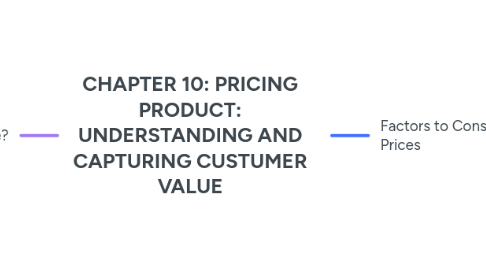
1. What Is Price?
1.1. The amount of money charged for a product or service
1.1.1. The sum of all the values that consumers give up in order to gain the benefits of having or using a product or service
1.2. The only element in the marketing mix that produces revenue; all other elements represent costs
2. Factors to Consider When Setting Prices
2.1. Customer Perception of Value
2.1.1. Effective customer-oriented pricing
2.1.2. Value-based pricing
2.1.2.1. Value-based pricing is customer-driven
2.1.2.2. Cost-based pricing is product-driven
2.1.2.3. Good-value pricing
2.1.2.3.1. The right combination of quality and good service to fair price
2.1.2.4. Value-added pricing
2.1.3. Everyday low pricing (EDLP)
2.1.4. High-low pricing
2.1.5. Value-added pricing
2.1.6. Pricing power
2.2. Company and Product Costs
2.2.1. Cost-based pricing
2.2.2. Types of costs
2.2.2.1. Fixed costs
2.2.2.1.1. Rent
2.2.2.1.2. Utilities
2.2.2.1.3. Interest
2.2.2.1.4. Executive salaries
2.2.2.2. Variable costs
2.2.2.2.1. Packaging
2.2.2.2.2. Raw materials
2.2.2.3. Total costs
2.2.2.3.1. The sum of the fixed and variable costs for any given level of production
2.2.2.4. Average cost
2.2.2.4.1. The cost associated with a given level of output
2.2.2.5. Experience or learning curve
2.2.2.5.1. When the average cost falls as production increases because fixed costs are spread over more units
2.3. Break-Even Analysis and Target Profit Pricing
2.3.1. Break-even pricing
2.3.1.1. The price at which total costs are equal to total revenue and there is no profit
2.3.2. Target profit pricing
2.3.2.1. The price at which the firm will break even or make the profit it is seeking
2.4. Overall Marketing Strategy, Objectives and Mix
2.4.1. Pricing objectives include
2.4.1.1. Survival
2.4.1.2. Profit maximization
2.4.1.3. Market share leadership
2.4.1.4. Customer retention and relationship building
2.4.1.5. Attracting new customers
2.4.1.6. Opposing competitive threats
2.4.1.7. Increasing customer excitement
2.4.2. Target costing
2.4.2.1. An ideal selling price based on consumer value
2.4.3. Non-price strategies
2.4.3.1. The marketing offer to make it worth a higher price
2.5. Organizational Considerations
2.5.1. Organizational considerations include
2.5.1.1. Who should set the price
2.5.1.2. Who can influence prices
2.6. The Market and Demand
2.6.1. Types of markets
2.6.1.1. Pure competition
2.6.1.2. Monopolistic competition
2.6.1.3. Oligopolistic competition
2.6.1.4. Pure monopoly
2.7. Types of Markets
2.7.1. Pure competition
2.7.1.1. A market with many buyers and sellers trading uniform commodities where no single buyer or seller has much effect on market price
2.7.2. Monopolistic competition
2.7.2.1. A market with many buyers and sellers who trade over a range of prices rather than a single market price with differentiated offers
2.7.3. Oligopolistic competition
2.7.3.1. A market with few sellers because it is difficult for sellers to enter who are highly sensitive to each other’s pricing and marketing strategies
2.7.4. Pure monopoly
2.7.4.1. A market with only one seller. In a regulated monopoly, the government permits a price that will yield a fair return. In a non-regulated monopoly, companies are free to set a market price
2.8. Analyzing the Price-Demand Relationship
2.8.1. Before setting prices, the marketer must understand the relationship between price and demand for its products
2.8.2. The demand curve
2.8.2.1. Normally, demand and price are inversely related
2.8.2.2. Higher price = lower demand
2.8.2.3. For prestige (luxury) goods, higher price can equal higher demand when consumers perceive higher prices as higher quality
2.9. Price Elasticity of Demand
2.9.1. Price elasticity of demand
2.9.1.1. illustrates the response of demand to a change in price
2.9.2. Inelastic demand
2.9.2.1. Occurs when demand hardly changes when there is a small change in price
2.9.3. Elastic demand
2.9.3.1. Occurs when demand changes greatly for a small change in price
2.9.4. Factors affecting price elasticity of demand
2.9.4.1. Unique product
2.9.4.2. Quality
2.9.4.3. Prestige
2.9.4.4. Substitute products
2.9.4.5. Cost relative to income
2.10. Competitors’ Strategies and Prices
2.10.1. Factors to consider:
2.10.1.1. Comparison of offering in terms of customer value
2.10.1.2. Strength of competitors
2.10.1.3. Competition pricing strategies
2.10.1.4. Customer price sensitivity
